Replica of 1863 Fashion Plate
I wanted to make this gown to use as the centrepiece of a new lecture, Mrs Beeton's Victorian Fashions 1857 - 1865. Mrs Beeton is usually associated with the cookery book which bears her name, first published in a single volume in 1861. In fact she was not a cook but worked as a writer for her husband's publication, The Englishwoman's Domestic Magazine (EDM). Between 1857 and her death in 1865 she provided various articles for the magazine and wrote or edited the fashion column.
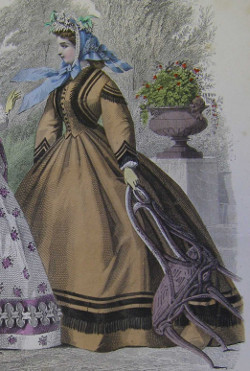
I decided to try to recreate a gown from an EDM fashion plate of July 1863. This dress is similar to many that survive in English collections and so I felt it would be fashionable and within the range of middle class women.
As usual with my work, I try to use items copied from originals held in museum collections across England. I have drawn on my personal researches to bring together an appropriate corset and crinoline for the date. In each case I have stayed faithful to the colours of the original garments; amethyst silk satin for the corset and red and buff for the crinoline. Mrs Beeton however would not have approved since she stated that "nothing can be in worse taste than to see a medley of colours in under-clothing."
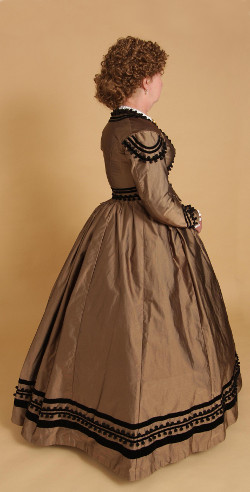 |
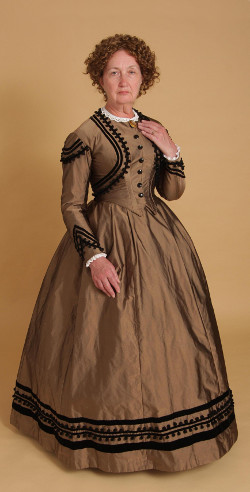 |
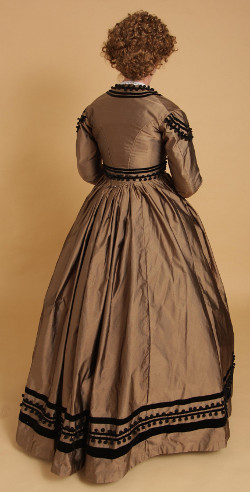 |
I had some rich brown silk with a slight rib which I felt was a good match to the colour of the fashion plate. Unfortunately I only had 4.4 metres of fabric, 143 cm wide but with careful cutting and piecing, this quantity was just enough. Piecing was the practice of joining off cuts to make use of every little bit of fabric. Usually piecing is planned to be as inconspicuous as possible and mine was at the ends of the sleeves – an area where I knew I would have trimming to disguise the joins.
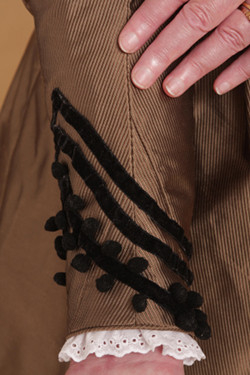
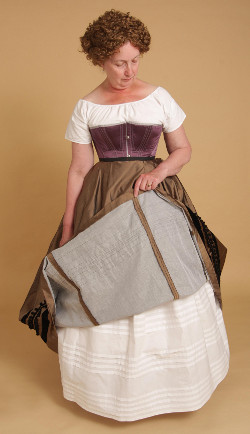
In the original plate the gown is trimmed with what appears to be black velvet ribbon and a black fringe. Suitable silk fringe was not available and so I substituted a synthetic ball fringe held down with velvet ribbon. I feel that this has kept the spirit of the fashion plate and was a solution open to a lady of the time. A reader of the EDM would not have wanted to copy a particular fashion plate but use it as inspiration for her own gown. For the purposes of my talk, however, I needed a gown which looked as close to the fashion plate as possible.
A single starched and tucked cotton petticoat is worn over the crinoline. By this date the petticoat would be cut in gores to closely fit the crinoline but for my purposes I chose to use a straight cut petticoat as not every lady would be up to date with all her underwear.
The skirt was cut in gores with two straight period widths of silk across the back where the opening is. Each panel was lined with cotton organdie before being machined together. At this date the sewing machine was in use and made quick work of large skirts such as this. The skirt seams were then overcast by hand to prevent fraying. Machine stitching was also used on the bodice but all trimming and the piping at sleeve ends, waist and around the neck was done by hand.
A single starched and tucked cotton petticoat is worn over the crinoline. By this date the petticoat would be cut in gores to closely fit the crinoline but for my purposes I chose to use a straight cut petticoat as not every lady would be up to date with all her underwear.
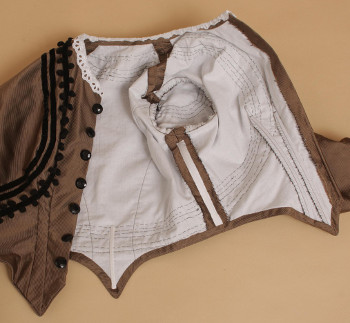 |
